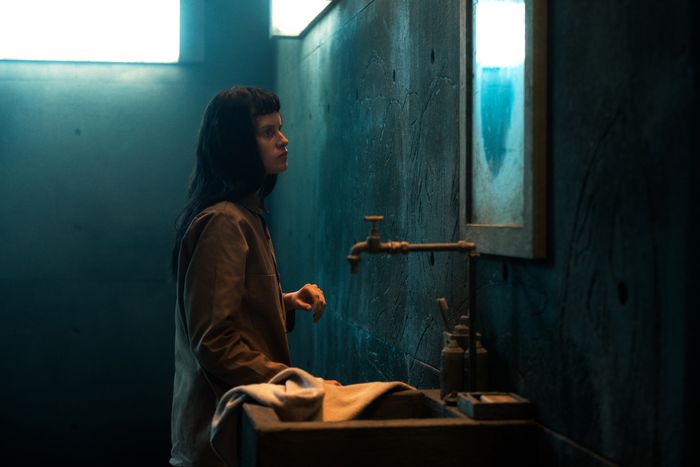
In a lot of ways, The Platform 2 is a prime example of diminishing franchise returns. Like its 2019 predecessor, this dystopian Spanish thriller is set in the Pit, a futuristic, towerlike hellhole penitentiary where the food arrives on a single dinner table that descends from the top floor each day and is reduced to a pile of dirty dishes long before it reaches the bottom, hundreds of floors below. Director and co-writer Galder Gaztelu-Urrutia milked that premise for about all it was worth the first time around. But because The Platform was a sleeper hit on Netflix, a second helping was all but inevitable. Unfortunately, Gaztelu-Urrutia hasnÔÇÖt so much varied or escalated his allegorical scenario as simply trotted it out again. That slowly lowering spread is actually a pretty good metaphor for what happens when a novel science-fiction conceit is, well, spread thin.
If thereÔÇÖs a saving grace to this dubiously necessary continuation, it lies in the ways Gaztelu-Urrutia has rethought the politics of his first movie. The Platform 2 may be an inferior regurgitation of The Platform in most respects, with a plot thatÔÇÖs a little too similar in basic direction, but it does capitalize on the opportunity to drag some new ideas into the Pit ÔÇö especially in the home stretch, when the movie goes as far as to pointedly complicate and even undercut the ending of the previous film. If nothing else, you have to admire how much it doubles down on the bleakness of its worldview to make a larger point about hope as a force of political change.
As a reminder, the first Platform ended with its audience-surrogate hero traveling to the very depths of the Pit in what amounted to a bold propaganda effort. If they could reach the bottom floor, and then send an item of untouched food back to the top, it would be proof that it is possible to share what theyÔÇÖve been provided to feed everyone. Once the crusaders land on the final floor, however, they discover an even more potent expression of their campaign: a little girl, still breathing, whose survival seems like living proof that food really can make it to the bottom. The child becomes the message. The movie ends with her literally rising, sent to the top on the platform that sends the food down, a symbol of hope for this cursed place.
But the ending of The Platform 2 extinguishes that hope in a rather withering way. Structurally, part two mirrors part one, with a new protagonist, Perempuan (Milena Smit), similarly determined to make her way to the lowest rungs of this ladder of inequality. What she finds at the bottom, though, is a dark truth about the Pit: Hiding among the bodies the overseers are clearing away, she witnesses them introduce a small, healthy child, just like the one discovered on floor 333 in the original. As it turns out, the people running the Pit are planting false symbols of hope. By creating the impression that a child can make it at the bottom, theyÔÇÖre selling the lie that itÔÇÖs possible to share the food theyÔÇÖre being provided, that thereÔÇÖs enough for everyone, that the system can work if they make it work. ItÔÇÖs an ending that completely recontextualizes the revolutionary optics of the first filmÔÇÖs closing minutes.
And itÔÇÖs even more damning once you suss out the actual timeline of events. For a while, it appears that The Platform 2 might be taking place in the aftermath of The Platform. The different system of food management, in which each inmate selects their own specific meal in advance (under the idealistic assumption that everyone will simply eat their share and nothing more), looks like the kind of institutional change that might come to fruition as a result of the originalÔÇÖs ending. In fact, for a while, itÔÇÖs tempting to read The Platform 2 as an allegorical look at what happens after a revolution, as a strictly capitalistic structure is replaced by an authoritarian regime whose rules of ÔÇ£fairÔÇØ resource distribution become another way to hold on to and exert power.
And then the film reintroduces Trimagasi (Zorion Eguileor), a character killed halfway through The Platform, and you realize youÔÇÖre actually watching a prequel, that everything youÔÇÖre seeing happened before the events of The Platform. With that knowledge, the entire first film becomes a portrait of people trying to transform a system they canÔÇÖt comprehend. Whereas the ending of the original once looked faintly optimistic ÔÇö maybe things will change in the Pit! ÔÇö it now looks like a pointless, futile gesture built on a lie. Given that the overseers are planting a new child every month, you have to also assume that what happens at the conclusion of The Platform has happened before and will happen again. The architects have folded inevitable revolutionary impulses into the very design of their unjust society.
ItÔÇÖs an epic downer, but Gaztelu-Urrutia isnÔÇÖt just dampening our spirits for the hell of it. ThereÔÇÖs a larger point to be gleaned from The Platform 2ÔÇÖs despairing ending. What the film seems to be saying is that in buying into the lie that a child (or anyone) could survive in the lower levels of the Pit, the inmates are taking the onus of survival off the one percent rationing out the resources and putting it on themselves. No matter how fair and equitable a system they devise, no matter how much they convince their fellow incarcerated to eat responsibly, there wonÔÇÖt be enough food for everyone, because the people running the prison simply arenÔÇÖt providing enough. You canÔÇÖt reform a system that doesnÔÇÖt provide for all. You can only escape it or tear it down. Maybe thatÔÇÖs where we should expect the series to go, in the likely scenario that Gaztelu-Urrutia pushes his luck further with a third Platform.

